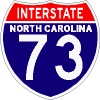I took a quick road trip this morning to take a drive on the portion of '128' from MA 24 to almost MA 109 whose additional 4th lanes were opened during November. I also tried to grab photos of signs I missed documenting during past road trips as well.
1. Northbound I-93/US 1
The additional lane begins at the MA 24 on-ramp. Here's the additional lane and the 2 new I-93/US 1 signs:
This was the last section of the new northbound to be opened. The view at the next exit:
That's the I-95 2-mile advance exit sign in the distance. There were some old and new signs between Exits 3 and 2:
The yellow sign on the right is new and reminds traffic that driving in the breakdown lane is no longer allowed. If you want confirmation that I-93 ends in 1 1/2/ miles (this is an old sign, not replaced), there's a new official 'End(!) I-93' sign:
Between the MA 138 and I-95 Exits there are now two additional lanes for the I-95 exit as seen above and in this photo:
The new lanes heading the other direction between I-95 and MA 138 are not finished yet, they are supposed to be open by the end of the year.
2. I-95 (128) North/US 1 South
A view of the new 4-lane configuration heading north on I-95 (or south on US 1). Notice also the new sound barriers along this stretch of highway:
The fourth lane continues past the US 1 South interchange. Can you find the MA 128 auxiliary signage?:
As for US 1, there are no route markers along the stretch of I-95 north from the beginning of its concurrency to its exit.
3. I-95 (128) South/US 1 North
Sorry for the sun, but here's the signage involved with the exit to I-95/MA 128 South (US 1 North) from US 1 South in Dedham:
Here's the new highway configuration approaching Exit 14 southbound:
I've just passed an old South US 1 reassurance marker placed there when the route was moved in 1989. There are no other US 1 signs heading this direction until approaching the I-93 North Exit. There, however, is a new South I-95 reassurance marker beyond the on-ramp from East St/Canton St:
No accompanying MA 128 shield though. The only one for 128 is the 'End 128' sign before the I-93 exit.
4. I-93/US 1 North
Here's the view of the now four-lane highway just after the MA 138 Exits:
The only remaining signage needed is an additional sign for Exit 2 Northbound just after the ramp from I-95 (currently marked by an temporary orange sign) and mile markers that were not placed in the construction zone when the rest of I-93 received them in 2010.
Work is now proceeding on adding an additional lane between MA 109 and MA 9. Work (and corresponding updated signage) is not supposed to be complete until 2016.
1. Northbound I-93/US 1
The additional lane begins at the MA 24 on-ramp. Here's the additional lane and the 2 new I-93/US 1 signs:
This was the last section of the new northbound to be opened. The view at the next exit:
That's the I-95 2-mile advance exit sign in the distance. There were some old and new signs between Exits 3 and 2:
The yellow sign on the right is new and reminds traffic that driving in the breakdown lane is no longer allowed. If you want confirmation that I-93 ends in 1 1/2/ miles (this is an old sign, not replaced), there's a new official 'End(!) I-93' sign:
Between the MA 138 and I-95 Exits there are now two additional lanes for the I-95 exit as seen above and in this photo:
The new lanes heading the other direction between I-95 and MA 138 are not finished yet, they are supposed to be open by the end of the year.
2. I-95 (128) North/US 1 South
A view of the new 4-lane configuration heading north on I-95 (or south on US 1). Notice also the new sound barriers along this stretch of highway:
The fourth lane continues past the US 1 South interchange. Can you find the MA 128 auxiliary signage?:
As for US 1, there are no route markers along the stretch of I-95 north from the beginning of its concurrency to its exit.
3. I-95 (128) South/US 1 North
Sorry for the sun, but here's the signage involved with the exit to I-95/MA 128 South (US 1 North) from US 1 South in Dedham:
Here's the new highway configuration approaching Exit 14 southbound:
I've just passed an old South US 1 reassurance marker placed there when the route was moved in 1989. There are no other US 1 signs heading this direction until approaching the I-93 North Exit. There, however, is a new South I-95 reassurance marker beyond the on-ramp from East St/Canton St:
No accompanying MA 128 shield though. The only one for 128 is the 'End 128' sign before the I-93 exit.
4. I-93/US 1 North
Here's the view of the now four-lane highway just after the MA 138 Exits:
The only remaining signage needed is an additional sign for Exit 2 Northbound just after the ramp from I-95 (currently marked by an temporary orange sign) and mile markers that were not placed in the construction zone when the rest of I-93 received them in 2010.
Work is now proceeding on adding an additional lane between MA 109 and MA 9. Work (and corresponding updated signage) is not supposed to be complete until 2016.












Comments